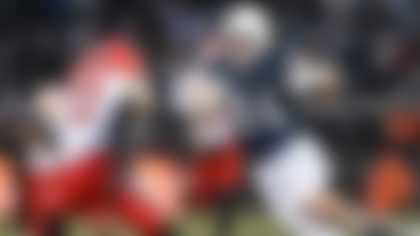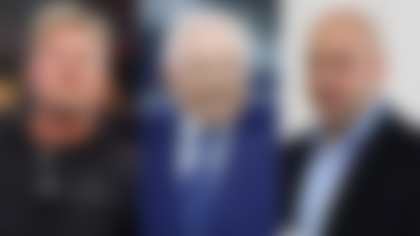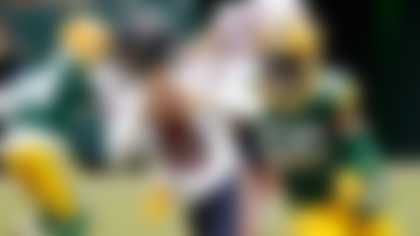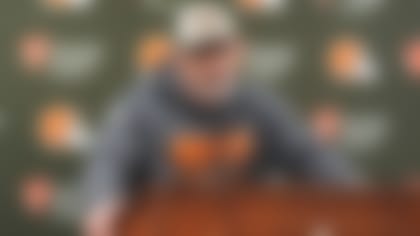The first time Herschel Walker touched the football for the Minnesota Vikings -- 25 years ago next Wednesday -- he took a kickoff four yards deep in the Metrodome end zone and raced 51 yards down the right sideline. And in the Texas Stadium press box, where the star halfback's flailing former team was muddling through another desultory defeat, there was an audible gasp as the highlight flashed across the TV screens viewed by normally jaded journalists.
The play was nullified by a penalty, but its impact reverberated throughout the football universe: There was the freakishly full-bodied and fleet-footed runner, only three days after having been acquired in a blockbuster trade with the Dallas Cowboys, returning an NFL kickoff for the first time and looking like Jim Brown in his prime.
The Trade: 25 years later

NFL Media takes an expansive, in-depth look at the Herschel Walker deal -- a true game changer in the world of sports. **READ**
Then it got even weirder: The next time Walker touched the ball, he took a handoff from Tommy Kramer, slipped through a hole to his right, blasted through a trio of would-be Green Bay Packers tacklers -- one of whom dislodged his right shoe -- and rambled ahead for a 47-yard gain.
At that surreal moment, in Minnesota and North Texas (where the Cowboys would fall to 0-6 after a defeat to the San Francisco 49ers) and everywhere else where in-game NFL highlights were shown, the buzz was perceptible, and the consensus nearly unanimous: The Vikings, a talented team coming off a divisional-round playoff appearance, had won the Walker trade -- and looked nothing short of Super.
"I'm looking downfield and he's running and I'm running behind him, I'm like, 'Yeah, keep going!' " recalled Steve Jordan, a six-time Pro Bowl tight end who played for the Vikings from 1982 to '94. "It was pretty awesome. You're thinking, OK ... he's going to kill it, this is what we're going to see on a regular basis.
"I don't remember very many happy memories after that."
Uh ... no.
As it turned out, the trade which sent Walker to the Vikings was even more lopsided than many of us suspected on that mid-October Sunday in 1989 -- only it wasn't the Cowboys who got snookered. That distinction belonged to Vikings general manager Mike Lynn, who, as the shoeless runner raced through the Packers' secondary, was the proudest man in America.
"I just know Mike Lynn was beaming in the press box ... visions of the cover of Sports Illustrated, if not the cover of Forbes," Jordan said. "But when you look at it in retrospect, it seems like he was just inept. Clearly, Mike Lynn was the last to know on this deal."
Conversely, Cowboys owner Jerry Jones and coach Jimmy Johnson -- the oft-lampooned pair of neophytes who'd taken over the storied franchise seven months earlier -- knew exactly what they were doing when they sent their only marquee player to Minnesota, and eventually it became obvious to the rest of the football world.
The premium draft picks obtained in the trade helped Jones and Johnson execute an extreme home makeover which contributed to the building of a dynasty. After a 1-15 season in '89, the Cowboys would quickly push their way into playoff contention and, beginning in 1992, capture three Lombardi Trophies in four seasons. When Johnson referred to the trade as "the great train robbery" in the press conference that announced the deal, he might as well have worn a Jesse James-style mask.
"Well, I'm sure the rest of the league felt just like everybody in Dallas," Johnson said during an extensive and revealing interview in Key Largo, Florida, late last month. "People said, 'These country bumpkins and this college coach got taken to the cleaners!' I'm sure they're saying, 'Minnesota gave up these players that they don't really need and they got Herschel Walker.' "
The Vikings got a 148-yard explosion from Walker in that memorable debut, and not a whole lot after that. He didn't even break the 1,000-yard barrier in any of his three seasons in Minnesota, and after ending that '89 season with another divisional-round playoff defeat, the Vikes missed the playoffs in '90 and '91. After that, Walker jumped to the Philadelphia Eagles, then to the New York Giants and, finally -- in what constituted the ultimate symbolic dagger -- returned to the Cowboys to close out his career.
By then, Lynn was long gone -- but the fallout from his ill-advised trade persisted.
"We were in a great position (in 1989), just poised for a lot of success," Jordan said. "And it all kind of came crumbling down. That trade set us back in a negative position for a number of years."
To appreciate the genesis of the trade, you have to understand the mystique of Walker, a physically gifted freak who burst upon the football scene as a University of Georgia freshman in 1980. During that season, the 18-year-old Walker looked like a man amongst middle schoolers, rushing for an NCAA freshman record and leading the Bulldogs to an undefeated season and a national championship. He should have won the Heisman Trophy -- the only thing that kept him from doing so, in my eyes, was that a freshman had never before won the award, and voters were reticent to break with tradition.
Walker ended up winning the Heisman as a junior in '82, then left school to join to the USFL, the only league at the time which allowed players to turn pro following their junior season. He got paid handsomely by Donald Trump, who bought the New Jersey Generals after Walker's rookie year, and ran for 2,411 yards in his third and final season before the league folded. Then he went to Cowboys and became an NFL star, setting the stage for the deal that rocked the NFL.
Early in the '89 season, Johnson and some of his assistant coaches were on their daily jog through the Valley Ranch neighborhood surrounding the Cowboys' training facility when the former University of Miami coach broached the idea of dangling Walker.
"I said, 'What do we have that the rest of the league might want?' " Johnson remembered. "This was before fantasy football -- this was before trades were commonplace. In the five years that I was with the Cowboys, we made 51 trades, more than the rest of the league put together.
"I saw the talent for the Cowboys and I said, 'Oh my god, we've got a problem.' And I told our guys, 'We've got to do something. If we are going to go by the standard NFL way and whenever our pick falls we're going to make a pick and try to improve our team that way, we are going to have a real problem, because we will be gone before this team ever gets better. It's too old a team and too bad a team.'
"And I said, 'We've got to jump-start it somehow ... You know, the only Pro Bowl player we've got is Herschel Walker.' And my offensive coaches said, 'We can't trade Herschel Walker; we won't score a point.' And I said, 'I can care less about scoring a point. We've got to get better two or three years from now.' "
So Johnson dangled Walker. The Cleveland Browns offered a package of high draft picks, but Lynn faxed an even more enticing proposal: The Vikings' first-round choice in 1992, plus five players (linebackers David Howard and Jesse Solomon, running back Darrin Nelson, cornerback Issiac Holt and defensive end Alex Stewart) tied to conditional picks, all in the first three rounds. Basically, the Cowboys had until the following Feb. 1 to decide whether to keep each player, or cut him and receive the corresponding pick.
To Johnson, this was a no-brainer.
"I didn't see the players," Johnson said. "I saw the picks. And so we go to the press conference and I said, 'We just had the great train robbery.' You know, I couldn't contain my enthusiasm because I knew what we were going to do. I couldn't even tell my coaches what we were going to do.
"Every one of those five players was better than what we had. And I knew Mike Lynn was saying, 'Well, they're better than anything he's got, because they are that bad of a football team, so they are going to fall in love with them.' "
To prevent that possibility, Johnson -- against the objections of his assistants -- refused to start any of the players acquired in the trade, even though "they were better than the guys playing ahead of them." Only three remained after the initial fallout, as Johnson recalled: "Alex Stewart didn't like the trade, so I cut him right off the bat. Darrin Nelson, he didn't like the deal, so we traded him (to San Diego, for a fifth-round pick) and worked a deal with Minnesota (sending the pick to the Vikings)."
Johnson wasn't done dealing with Lynn -- at season's end, he informed the Vikings GM that he planned to cut Solomon, Howard and Holt, meaning he'd get the picks in question. Then, Johnson remembered, "I said, 'Let's work out a deal and you'll let us keep (the three players) and I'll kick you back something.' He said no and was irritated and hung up on me."
Eventually, Lynn called back and agreed to Johnson's terms in exchange for picks in the third and 10th rounds. The Cowboys -- though it can't be directly traced, given the amount of wheeling and dealing that ensued in coming drafts -- parlayed the ammo into future Hall of Fame halfback Emmitt Smith, All-Pro safety Darren Woodson, star cornerback Kevin Smith and standout defensive tackle Russell Maryland. The trade wasn't the reason Jones and Johnson built a dynasty, but it sure helped.
The Vikings, meanwhile, suffered the equal and opposite reaction. Losing those five players, Jordan said, messed with Minnesota's chemistry and created animosity in the locker room. "You know that next day (after the trade) when the name tags were being replaced on the lockers was a pretty solemn day, and then Herschel comes in after that," he said. "It was a tough situation."
It didn't help that Walker, who was best suited to the I-formation, was being thrust into a system that featured split backs.
"The trade itself was very ill-conceived," Jordan said. "I mean, it was the (sixth) week of the season. We didn't have the advantage of training camp to get the team on the same page. Herschel was not our style of running back. So now do you retrain 10 guys to one guy's system, or one guy to the other 10?"
Even as Walker made his stellar debut, with Lynn awash in *I'm the King of the World* gloating, Jordan and his teammates were already sowing the seeds of skepticism.
"I'd say within the first week, to be honest, you knew that this wasn't going to work out," Jordan said. "You know, again, it was that obvious. In practice, absolutely, you could tell. The camaraderie of that team, it had taken a few years to get there -- gone. The scheme didn't fit. And it became pretty obvious that this was not a love connection."
And for the Cowboys? A quarter-century later, what's not to love?
Follow Michael Silver on Twitter @MikeSilver.












